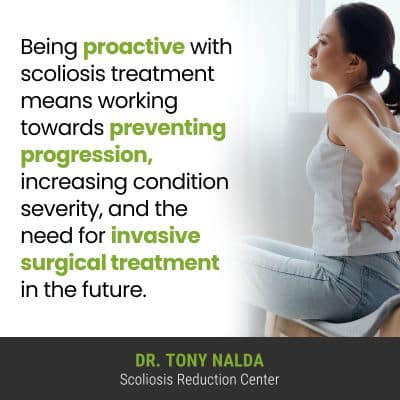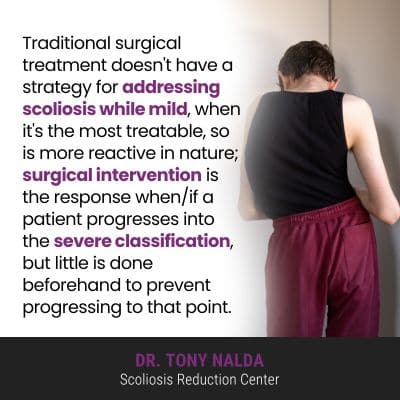When it comes to scoliosis treatment, the traditional response is surgical, but modern conservative nonsurgical treatment also has proven results. Treatment efficacy can be shaped by how a diagnosis of scoliosis is responded to; traditional treatment often recommends watching and waiting, while conservative treatment is proactive and starts treatment immediately.
It’s important for patients to understand what different treatments have to offer. The two main scoliosis treatment options include a traditional surgical response, and a conservative nonsurgical treatment option; patients have to decide which approach offers the best potential outcome.
As a patient’s scoliosis journey starts with a diagnosis, let’s start with how the condition is diagnosed.
How is Scoliosis Diagnosed?
Scoliosis is diagnosed through a combined physical examination and X-ray results.
A scoliosis screening examination is a medical evaluation that includes taking the patient’s family history, examining the trunk and spine for signs of asymmetry while patients bend forward, and if indicators of scoliosis are found, this warrants the need for further testing, involving a scoliosis X-ray.
Scoliosis is the development of an unnatural sideways spinal curve, but to be considered a true scoliosis, the curve has to have a rotational component, and in addition, the unnatural curvature of the spine has to have a Cobb angle measurement of at least 10 degrees.
Part of diagnosing scoliosis involves further classifying conditions based on important patient and condition factors; patient age, condition type, severity, and curvature location inform the customization of effective treatment plans.
There are never treatment guarantees, but in cases that are diagnosed early and met with a proactive treatment response, there are fewer limits to what can be achieved.
But what exactly does proactive mean in the context of scoliosis treatment?
Proactive Scoliosis Treatment
Being proactive means looking ahead; it means putting the work in place beforehand to guide a situation favorably.
As a progressive condition, scoliosis has it in its nature to get worse over time, and this means that the condition’s uneven forces are going to increase, as are their effects, and as a scoliosis curve increases in size, the condition gets more complex to treat; scoliosis is incurable, but it can be highly treatable.
Scoliosis ranges in severity from mild scoliosis, moderate scoliosis, severe and very severe scoliosis, and this is also the condition’s progressive line.
In addition to ranging so widely in severity, there are also different types of scoliosis a person can develop, and the most prevalent type overall is adolescent idiopathic scoliosis, diagnosed between the ages of 10 and 18, so we’ll focus on this condition type currently.
Being Proactive Can Help Counteract Progression
The majority of scoliosis cases are classified as idiopathic scoliosis, which means not clearly associated with a single-known cause, but we do understand what makes it progress: growth.
Scoliosis associated with known causes are considered atypical and includes neuromuscular scoliosis, degenerative scoliosis (affects older adults), and congenital scoliosis.
So for adolescents who are in, or entering into, the stage of puberty, this age group is the most at risk for rapid-phase progression due to rapid and unpredictable growth spurts.

Particularly in childhood scoliosis, as a child grows, a focus of scoliosis treatment has to be on how to counteract the condition’s progressive nature, reduce the size of the scoliotic curve, and hold the reduction despite the constant trigger of growth and development occurring.
So when treating adolescent scoliosis, the goal is to work towards a significant curvature reduction and maintain that reduction for corrective treatment results, and early intervention is associated with treatment success.
As an unnatural spinal curvature gets more severe, it’s getting larger, and as the condition progresses, the spine becomes increasingly rigid, and this makes it less responsive to treatment, and it can also make it difficult for some patients to perform key therapeutic exercises as part of treatment.
In addition, increasing symptoms of scoliosis commonly involve postural changes (uneven shoulders, uneven shoulder blades, the development of a rib cage arch, etc), along with changes to how clothes fit, balance, coordination, and gait.
While there are no guarantees, in general, it’s far more effective to proactively work towards preventing progression and increasing effects, than it is to attempt to reverse overt effects once they’re established; the longer scoliosis is left untreated, the more complex it will be to treat, and the more likely it is to cause related complications (lung impairment, digestive issues, muscle weakness, nerve damage, leg pain, etc).
Being proactive with scoliosis treatment means working towards preventing progression, increasing condition severity, and the need for invasive surgical treatment in the future.
Now that we’ve explored the concept of proactive scoliosis treatment, let’s address the specifics of what a conservative nonsurgical scoliosis treatment involves.
What Does Conservative Scoliosis Treatment Entail?
Here at the Scoliosis Reduction Center®, I believe in the power of proactive treatment for scoliosis because it can help spare patients the hardships associated with progression, increasing effects, and the need for invasive scoliosis surgery.
Scoliosis surgery is a type of spinal fusion, and this commonly involves fusing the curve’s most-tilted vertebrae into one solid bone, and metal rods attached to the spine to hold it in place, and while there is still a place for spinal fusion in scoliosis treatment, the reality is that many cases of scoliosis don’t require surgical treatment, and surgical treatment always comes with its share of potential risks, side effects, and complications, particularly spinal surgery.
And the younger a child’s age is at the time of the procedure, the longer the hardware used has to last and perform optimally; if a rod breaks, cracks, and/or a screw comes loose, the only recourse is more surgery.
A spine that’s fused is not going to be as flexible or strong as a spine that’s treated with conservative corrective treatment by integrating multiple scoliosis-specific treatments for scoliosis to impact conditions on every level.
Conservative treatment applies chiropractic care, physical therapy, scoliosis-specific exercises (SSES), corrective bracing, and rehabilitation.

Traditional surgical treatment doesn’t have a strategy for addressing scoliosis while mild, when it’s the most treatable, so is more reactive in nature as surgical intervention is the response when/if a patient progresses into the severe classification, but little is done beforehand to prevent progressing to that point.
Should I Treat My Scoliosis with Surgical or Nonsurgical Treatment?
I can never give treatment guarantees, no one can do that, but what I do know is that conservative treatment is more natural and strives to preserve as much of the spine’s natural strength and function as possible.
What I also know is what I have seen and heard from patients post-spinal fusion; many are disappointed with the loss in spinal flexibility and range of motion they are left with, and others experience increased back pain at the fusion site, and particularly when it comes to adolescents, many patients are disappointed with the cosmetic results of spinal fusion.
Nonsurgical conservative treatment relies on chiropractic care to work towards adjusting the position of the curve’s most-tilted vertebrae; this is far more natural than fusing the bones and artificially holding the spine in place with metal rods and screws.
First and foremost, as a structural spinal condition, its underlying structural nature has to be impacted (chiropractic care), and once structural results are in place, physical therapy and scoliosis-specific exercises can help increase spinal flexibility, increase core strength so the spine’s surrounding muscles can optimally support it, address any related muscular imbalance, abnormal posture, relieve pain, and activate specific areas of the brain for improved brain-body communication.
Corrective bracing can be particularly effective on growing spines so is a regular facet of adolescent idiopathic scoliosis treatments, and this can help by pushing the spine into a corrective position; again, very different from using hardware that is going to keep the spine rigid, immovable, more vulnerable to injury, and can malfunction over time.
Rehabilitation can involve continued chiropractic care and the prescription of a series of custom-prescribed home exercises for further stabilizing and healing the spine.
Conclusion
The most important decision a patient can make is how to treat their scoliosis, and the best advice I can give, when it comes to knowing which treatment approach to commit to, is to ensure that all treatment options, and the way they can shape long-term spinal health and function, are fully understood.
For patients, and parents and/or caregivers of a loved one recently diagnosed, be selective with scoliosis treatment providers; I don’t recommend having a general practitioner treat scoliosis because the condition’s complexities are beyond the scope of general medical care, instead requiring the expertise and training of a scoliosis specialist.
Also, don’t be afraid to ask prospective treatment providers questions; knowledge is power, and knowing the right questions to ask can help ensure a patient’s treatment expectations are aligned with the reality of the chosen approach’s potential outcome.
So remember, traditional scoliosis treatment is likely to funnel patients towards spinal fusion surgery, while modern conservative treatment offers a proactive nonsurgical treatment alternative with proven results.




